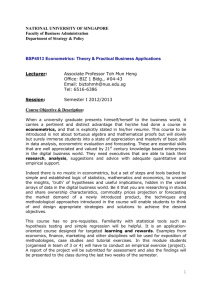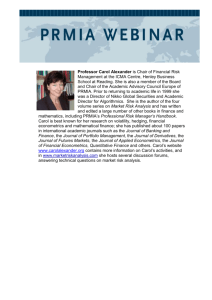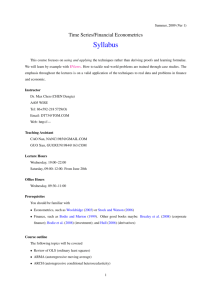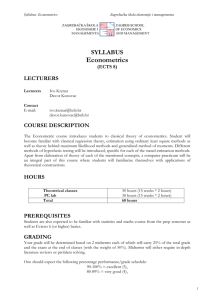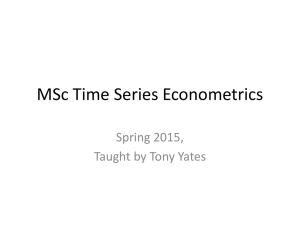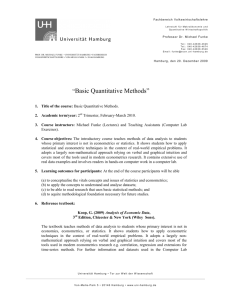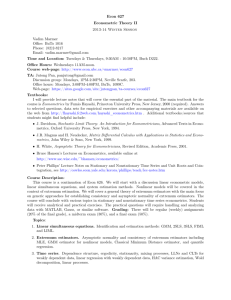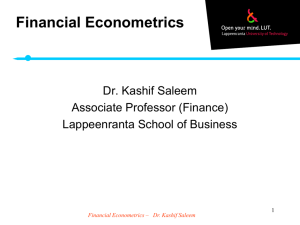Financial Econometrics Syllabus
advertisement
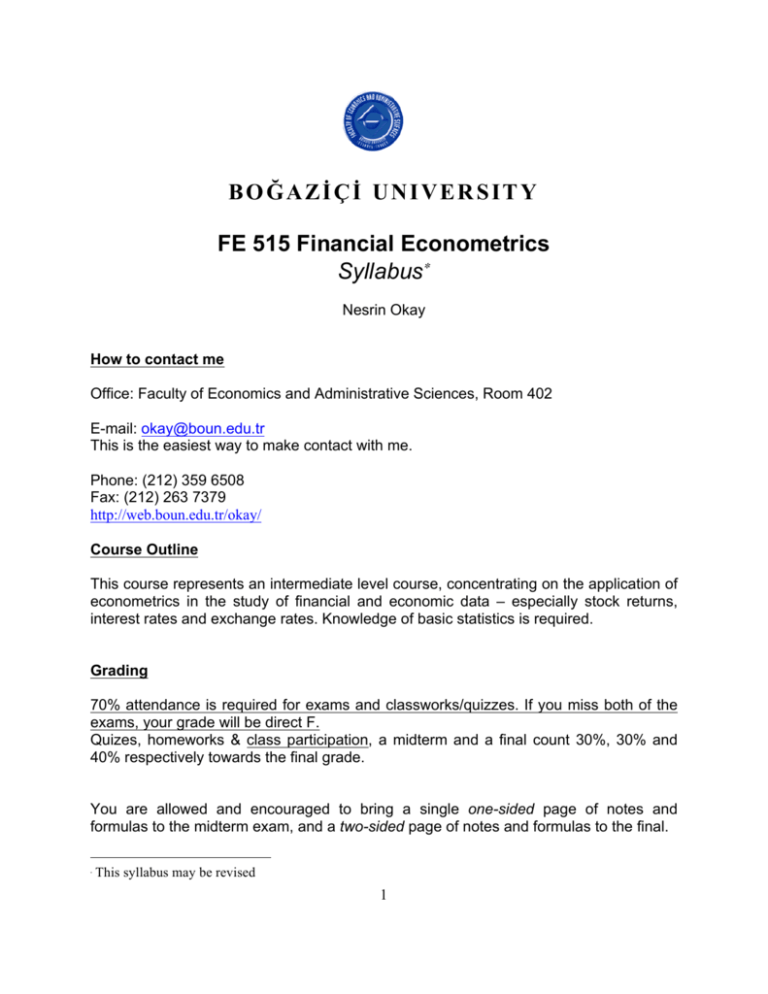
BOĞAZİÇİ UNIVERSITY FE 515 Financial Econometrics Syllabus∗ Nesrin Okay How to contact me Office: Faculty of Economics and Administrative Sciences, Room 402 E-mail: okay@boun.edu.tr This is the easiest way to make contact with me. Phone: (212) 359 6508 Fax: (212) 263 7379 http://web.boun.edu.tr/okay/ Course Outline This course represents an intermediate level course, concentrating on the application of econometrics in the study of financial and economic data – especially stock returns, interest rates and exchange rates. Knowledge of basic statistics is required. Grading 70% attendance is required for exams and classworks/quizzes. If you miss both of the exams, your grade will be direct F. Quizes, homeworks & class participation, a midterm and a final count 30%, 30% and 40% respectively towards the final grade. You are allowed and encouraged to bring a single one-sided page of notes and formulas to the midterm exam, and a two-sided page of notes and formulas to the final. ∗ This syllabus may be revised 1 All requests for re-grading must be submitted within 7 days of the return of the exam. Obvious errors will be corrected at no risk to the student. All other re-grading requests will result in the re-grading of the entire exam. Downward as well as upward revisions of a grade are possible. Required Textbook The required textbooks, 1-, Newbold, Carlson and Thorne , Statistics for Business and Economics, last Edition, Prentice-Hall, is available at the Boğaziçi bookstore. 2-Chris Brooks (CB), Introductory Econometrics for Finance, Cambridge University Press, last edition, is available at the Boğaziçi Bookstore. Assigned readings should be completed prior to the class meeting. Softwares You are strongly encouraged to use Eviews and Excel to reproduce the results of various examples and applications discussed in this book. References Camphell, Lo, MacKinlay, 1997, The Econometrics of Financial Markets, Princeton University press (CLM) Griffiths, Hill and Judge, 1993, Learning and Practicing Econometrics. Wiley and Sons. H. Russell Fogler and Sundaram Ganapathy, Financial Econometrics Walter Enders, Applied Econometric Time Series, John Wiley & Sons, last edition Course web addresses http://web.boun.edu.tr/okay/ http://www.prenhall.com/newbold/ http://www.cambridge.org/uk/catalogue/catalogue.asp?isbn=052179367X 2 Class Lab IIBF LAB Office Hours Feel free to get in touch with me any time you want to see me. Suggestions If you have suggestions about how to improve the course, please feel free to leave me a note—anonymous if you wish. Recitation Session M 11-12-13, in IIBF LAB Güney Kampüs Financial Econometrics Detailed outline (Tentative) Statistics Review (Newbold 1-13) Basic statistical concepts and tools needed for business applications. The topics covered are: (i) Data and Statistics (ii) Probability; (iii) Sampling Theory; (iv) Stationary Time Series; (v) Linear Regression; Financial Econometrics (CB 1-8) 1. Introduction – - Introduction to financial data and tools and analysis ;(CB, Chapter 1,2) 2. Classical Linear Regression – 3 - Classical Linear Regression and assumptions; (CB, Chapter 3) 3. Classical Linear Regression (continued) –; (CB, Chapter 4) 4. ARMA Modeling;(CB, Chapter 5) -Univariate times series modeling and Box Jenkins Approach -Additional Reading will be available at the class web pages 5. Multivariate Time Series Models - ¸(CB, Chapter 6) - Multivariate Time Series Modeling (VAR, impulse response, variance decomposition) -Additional Reading will be available at the class web pages 6. Modeling Long-Run Relationship - ¸(CB, Chapter 7) -Stationarity, unit root testing, cointegration, error correction -Additional Reading will be available at the class web pages 7. Volatility -(CB, Chapter 8) -Introduction to the theory and practice of GARCH models -Lecture notes and additional reading will be available at the class web pages 8. Volatility and Value-at-Risk – -Deeper discussion of GARCH models including Value-at-Risk -Lecture notes and additional reading will be available at the class web pages 9.Switching Models (CB, Chapter 8) -Seasonality, Markov switching, threshold autoregression -Additional Reading will be available at the class web pages 4
